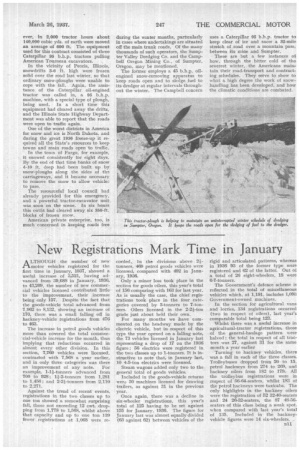New Registrations Mark Time in January
Page 45

If you've noticed an error in this article please click here to report it so we can fix it.
AkLTHOUGH the number of new ins motor vehicles registered for the first time in January, 1937, showed a useful increase of 3,521, having advanced from 39,688 in January, 1936, to 43,209, the number of new commercial vehicles licensed contributed little to the improvement, their increase being only 157% Despite the fact that the goods-vehicle total advanced from 7,962 to 8,132, showing an increase of 170, there was a small falling off in hackney-vehicle registrations from 476 to 463.
The increase in petrol goods vehicles more than covered the total commercial-vehicle increase for the month, thus implying that reductions occurred in almost every other division. In this section, 7,760 vehicles were licensed, contrasted with 7,568 a year earlier, and in only three categories was there an improvement of any note. For example, 1-11-tonners advanced from 700 to 928; 11-2-tonners from 1,281 to 1,456; and 2-21-tonners from 2,110 to 2,271.
Against the trend of recent events, registrations in the two classes up to one ton showed a somewhat surprising fall, those not exceeding 12 cwt. dropping from 1,778 to 1,568, whilst above that capacity and up to one ton 139 fewer registrations at 1,068 were re
corded, In the divisions above 2tonners, 469 petrol goods vehicles were licensed, compared with 492 in January, 1936.
Only a minor loss took place in the section for goods oilers, this year's total of 150 comparing with 163 for last year. As is usually the case, the chief registrations took place in the four categories covered by 3-tonners to 7-tonnets. Oilers licensed in the 2-21-ton grade just about held their own.
For many months we have commented on the headway made by the electric vehicle, but in respect of this type the year opened on a falling note, the 73 vehicles licensed in January last representing a drop of 17 on the 1936 figure 56 electrics were registered in the two classes up to 1-tonners. It is instructive to note that, in January last, 10 4-5-ton electrics were licensed.
Steam wagons added only two to the general total of goods vehicles.
Included in the goods-vehicle returns were 30 machines licensed for drawing trailers, as against 31 in the previous year.
Once again, there was a decline in six-wheeler registrations, this year's total of 125 having to be set against 155 for January, 1930. The figure for January last was almost equally divided (63 against 62) between vehicles of the
rigid and articulated. patterns, whereas in 1936 93 of the former type were registered and 62 of the latter. Out of a total of 26 eight-wheelers, 18 were 6-7-tormers.
The Government's defence scheme is reflected in the total of miscellaneous vehicles which, at 1,191, includes 1,093 Government-owned machines.
In the section for agricultural vans and lorries, 134 registrations occurred (two in respect of oilers), last year's comparable total being 123.
Whilst there was a useful increase in agricultural-tractor registrations, those of the general-haulage pattern were halved ; the total in respect of all tractors was 27, against 31 for the same month a year earlier Turning to hackney vehicles, there was a fall in each of the three classes. Trolleybuses dropped from 20 to 15, petrol hackneys from 274 to 269, and hackney oilers from 182 to 179. All the trolleybus registrations were in respect of 56-64-seaters, whilst 183 of the petrol hackneys were taxicabs. The only highlights in the hackney oilers were the registration of 52 32-40-seaters and 24 26-32-seaters, the 87 48-56seaters of this class being a weak spot. when compared with last year's total of 135. Included in the hackneyvehicle figures were 14 six-wheelers.




















































































